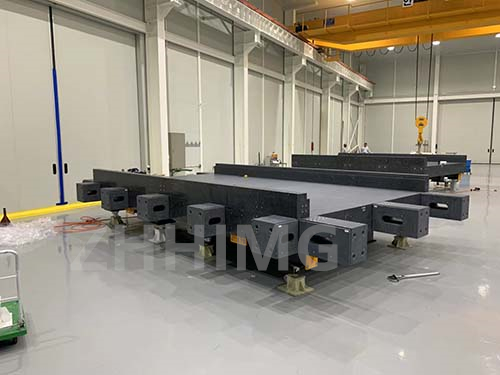Granite assembly has become increasingly popular in the semiconductor manufacturing process due to its unique properties. The overall process involves using granite as a base material onto which various components are attached to create a device or a machine. There are several advantages and disadvantages of using granite assembly in semiconductor manufacturing processes.
Advantages
1. Stability and rigidity: Granite is an extremely stable material with very low thermal expansion. This means that devices assembled on granite have very little movement or distortion due to thermal expansion or contraction, which results in a more reliable and consistent output.
2. High precision and accuracy: Granite is a material that has excellent dimensional stability and very low surface roughness. This translates into high accuracy and precision when manufacturing semiconductor devices, which can be crucial for applications where micron or even nanometer level tolerances are required.
3. Thermal conductivity: Granite has relatively high thermal conductivity, which means it can efficiently dissipate heat from the devices that are being assembled on it. This can be very useful when dealing with high-temperature processes such as wafer processing or etching.
4. Chemical resistance: Granite is a natural stone that is immune to most chemicals that are used in the semiconductor manufacturing process. This means that it can withstand harsh chemical environments without showing any signs of degradation or corrosion.
5. Long lifespan: Granite is a highly durable material that has a long lifespan. This translates into a low cost of ownership for equipment built using granite assembly.
Disadvantages
1. Cost: Granite is an expensive material, which can add to the overall cost of manufacturing equipment that uses it.
2. Weight: Granite is a heavy material, which can make it difficult to handle and transport. This can be a challenge for companies that need to move their equipment frequently.
3. Limited availability: Not all regions have a ready supply of high quality granite, making it difficult to source the material for use in manufacturing equipment.
4. Difficulty in machining: Granite is a difficult material to machine, which can increase the lead time for the production of equipment. This can also increase the cost of machining due to the need for specialized tools and expertise.
5. Limited customization: Granite is a natural material, and therefore, there are limits to the degree of customization that can be achieved. This may be a disadvantage for companies that require a high degree of customization or flexibility in their manufacturing process.
In conclusion, there are both advantages and disadvantages to using granite assembly in the semiconductor manufacturing process. While the cost and weight of the material can be a challenge, the stability, precision, and chemical resistance make it an ideal material for building reliable and high-precision equipment. With careful consideration of these factors, companies can decide whether granite assembly is the right solution for their semiconductor manufacturing needs.
Post time: Dec-06-2023

